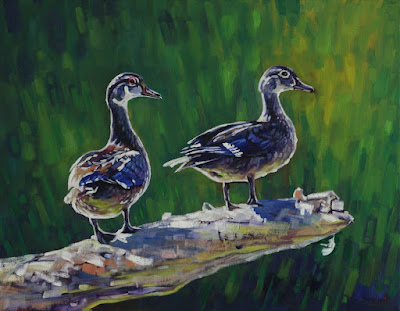 |
| #2849 "Wood Ducks Standing on the Log By the Bay" 14x18 inches oils on stretched canvas Started Friday March 29th, 2024 |
The title of this painting was inspired by the song with a similar name. "(Sittin' On) The Dock of the Bay" is a song co-written by soul singer Otis Redding and guitarist Steve Cropper. Redding recorded it twice in 1967, including just three days before his death in a plane crash on December 10, 1967. The song is still popular on the oldies station.
This is another image taken by my friend, John Verburg, a naturalist and terrific photographer. John provides a tremendous source of inspiration during the winter when the windchill encourages me to stay within the Singleton Studio.
These are a Drake (left) and a hen (right) juvenile wood ducks in September of 2024. They had been busy preening their feathers and discarding fluffy castaways on the log.
 |
| Map of the location of wood duck houses within the Singleton Sanctuary |
We have about twenty wood duck boxes within the Singleton Sanctuary and they are heavily used. Like the Peterson Blue Bird Houses and other structures, we have provided, "build it and they will come". We enjoy seeing lots of wood ducks within the Singleton Sanctuary. They arrive in early March and stay into October.
Drake wood ducks have red eyes without an eye ring. Hen wood ducks have dark eyes and a tear-drop-shaped white eye ring. The drake's bill is red, with a yellow band at the base and a black line above the nostrils to the tip. Legs and feet are dark yellow. The hen is mostly brownish-olive overall, with white streaks on the breast.
Note that both loon genders have red eyes possibly to aid in underwater vision. The male loons are 25 percent larger than the female but otherwise, they are identical.
Wood Ducks are built to navigate the tight quarters of their preferred swampy habitat: A long, wide tail and powerful, broad wings allow them to nimbly fly through trees and branches. Their relatively large eyes absorb more light which is very useful for seeing under shaded conditions of dense forests. Female wood ducks make loud "oo-eek, oo-eek" when disturbed and taking flight. The Drakes have thin, rising and falling whistles.
The Wood Duck is a secretive cavity-nesting species commonly found in swamps, marshes, and riparian habitats in Canada. In Canada, it breeds primarily in the eastern provinces. Wood Ducks were nearly hunted to extinction during the late 19th and early 20th centuries. Management efforts have been successful and there are now well over a million Wood Ducks in North America. I wish there were many more than that!
Nearly 90 percent of wood ducklings die within the first two weeks, mostly due to predation. The female protects her young until they can fly, about 60 days after hatching. Wood ducks usually live 3 to 4 years but can live as long as 15 years. We often see wood duck broods with more than eight ducklings even late in the summer. Perhaps the predation of young wood ducks is not quite so high within the Singleton Sanctuary.
The Wood Duck is a distinctively North American species. Its only close relative is the Mandarin Duck of eastern Asia. Evidently the Wood Duck originated in North America, as fossil remains have been found only in widely scattered locations in the eastern part of the continent.
I use these art posts to also relearn or discover for the first time, some natural history facts about the world around us. It is more of a challenge to assist and preserve something that one does not understand or appreciate. Thank you for reading this far... Education is a way of life and may it never get old.
For this and much more art, click on Pixels or go straight to the Collections. Here is the new Wet Paint 2024 Collection.
Warmest regards and keep your paddle in the water,
Phil Chadwick
_The_Dock_of_the_Bay_by_Otis_Redding_US_vinyl.jpg)







No comments:
Post a Comment